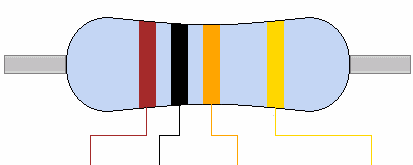10k Resistor Color Code Meaning
What is the 10k resistor color code? 5 band resistor color code calculator.


The 4 band 10k resistor color code is along the lines:



10k resistor color code meaning. The resistor value is read from the left to right. The 1 st color band indicates the 1 st significant value or 1 st digit of the resistors value. So the total value of the resistance given by the colors is 10 x 10 2 ω = 1000 ω = 1kω.
These colour bands are known as resistor colour code. Certain precision resistors with tolerance of 2 %, 1 %, or less are generally color coded with five bands as shown in figure given below: Five band resistor color code chart.
And tolerance considered as ==> 5%of1000 ==> 50ω. The first two figures in the code indicate the significant figures, and the third is a multiplier. It describes the coding standard for both resistors and capacitors.
Again, we check the resistor color code chart for red, violet and yellow, and the first, second and third bands give the significant digits of 2,7 and 4 respectively. The two first numbers represent a code that indicates a resistance value with three significant digits. Resistors cases usually have three to six bands that indicate their resistance, tolerance and sometimes their temperature coefficient of resistance (tcr).
In this case the band colors are red, orange, violet, black, and brown. In the color code table, green has a value of 5 which is the 1st digit, brown has a value of 1 which is the second digit and. 10k / 10k ohm resistor colour code.
If the colors on a 6 band resistor is in this order: 2 numbers to indicate the resistor value and 1 letter for the multiplier. The first band is brown means 1, the second band is black means 0 and the third band is orange and tolerance can have any color.
Gives the value of the tolerance for the resistor. The fourth band is black, giving a multiplier value of 10 0. The tolerance value tells the accuracy at which the resistor is manufactured.
The resistor colour code was invented in the 1920s by the radio manufacturers association (rma). Above is an example of a 5 band resistor. The bands are read from left to right.
Orange (3), red (2), brown (1), brown (x10), green (1%), red (50 ppm/°c) represents a 3.21 kω resistor with a 1% tolerance and a 50 ppm/°c temperature coefficient. ‘c’ represents the 3 rd significant digit, which is the third band color of resistor. You must select the right color corresponding to each column.
Resistors are usually very tiny, and it is challenging to print resistance values on them. What is resistor colour code? In this case, the third band is red which corresponds to the number 2.
This tool is used to decode information for color banded axial lead resistors. Green, brown, violet, black, gold and orange. 4 band resistor color code calculator.
Red = 2 (hundreds place) orange = 3 (tens place) violet = 7 (ones place) black = 1ω. In this system, the marking exists out of three digits: ‘b’ represents the 2 nd significant digit, which is the second band color of resistor.
Therefore an smd resistor with the figures 472 would have a resistance of 47 x 10 2 ohms, or 4.7kω. 10k resistor color code is as shown in the image it is brown/black/orange/gold, colour code of resistors does not depend on the power rating of resistor, the power rating of the resistor depends on its physical size and comes under standard wattage rating of. So, colour bands are printed on them to represent the electrical resistance.
Begin at the band closest to one end.the first band is the first digit of the resistance value,the second band is the second digit,the third band is the third digit,the. Thus, the actual value of the 1 kilo ohm can be between 950 ohms and 1050 ohms. The values of color bands will be like this:
Mnemonics for remembering color codes. Try this out by using our resistor color code calculator or you can. Hence, we will get a resistance value of 274 × 10 0 = 274ω.
Therefore the multiplier is 10 2 = 100. Mnemonics are the only way i can. They are usually higher precision resistors.
This means that for a temperature change of 10 ˚c, the resistance value can change 1000 ppm = 0.1%. Where, ‘a’ represents the 1 st significant digit, which is the first band color of resistor. 6 band resistor color code calculator.
1st band= brown= 1 (1st digit) 2nd band= black= 0 (2nd digit) 3rd band= red= 100 (multiplier) 4th band= gold= ±5% (tolerance) therefore, 10 ×100±5% ==> 1000ω ==> 1kω. Band = blue = 10 ppm temperature coefficient. For the 6 band resistor example shown above:
Black represents ‘0’ and red represents the multiplier ‘100’. The resistance calculator has 1 to 6 band colors with multiplier (mul) and tolerance (tol) and ppm/kelvin. If there is no tolerance band, then find the side that has a band closest to a lead and make that the first band.
The coding is defined in the international standard iec 60062:2016. Green = 5, brown = 1, violet = 7, black = 100, gold = 5%, orange = 15ppm. The 4 color bands on the left side are grouped together to represent the resistance value of a resistor and the 5 th color band on the right side indicates the tolerance of the resistor.
This is the same as the coloured rings used for wired resistors, except that actual numbers are used instead of colours.




















Komentar
Posting Komentar